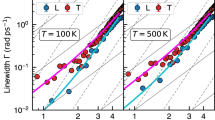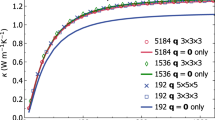Abstract
The possibility of the application of the R.L. Muller model of the microheterogeneous structure of glass for the description of the nature of the conduction various glass classes, the electric conduction of which is due to the migration of cations, anions and the combined migration of cations and electrons, has been considered. It was shown that the appearance and the subsequent increase in the ionic conduction can be explained using the concentration variation of the blocking extent function (γ), which is calculated based on the analysis of the ratio of the concentration of nonpolar and polar structural fragments—structural-chemical units in the bulk of glass. On the whole, the methodology of the calculation of the concentration γ values for various glass systems coincides, except for some features in halogen-containing systems that required additional specifications.
Similar content being viewed by others
References
Myuller, R.L. and Shchukarev, S.A., Investigation of the electrical conductivity of glasses in the B2O3-Na2O system, Zh. Fiz. Khim., 1930, vol. 1, no. 6, pp. 625–661.
Myuller, R.L., Elektroprovodnost’ stekloobraznykh veshchestv: Sbornik trudov (Electrical Conductivity of Vitreous Materials: A Collection of Works), Leningrad: Leningrad State University, 1968.
Sokolov, I.A. and Borisova, Z.U., On the nature of electrical conductivity of metal-containing chalcogenide glasses, Fiz. Khim. Stekla, 1985, vol. 11, no. 3, pp. 304–310.
Naraev, V.N. and Pronkin, A.A., A Study on the nature of electric current carriers in glasses of the Na2O-P2O5 system, Glass Phys. Chem., 1998, vol. 24, no. 4, pp. 361–365.
Pronkin, A.A., Murin, I.V., Sokolov, I.A., and Ustinov, Yu.N., Physicochemical properties of glasses in the Li2O-P2O5 system, Glass Phys. Chem., 1997, vol. 23, no. 5, pp. 383–388.
Pronkin, A.A. and Kogan, V.E., Electrical conductivity of glasses in the PbO · SiO2-Pb(Hal)2 (Hal = Cl, Br, I) system, Fiz. Khim. Stekla, 1994, vol. 20, no. 3, pp. 386–391.
Sokolov, I.A., Murin, I.V., Wiemhufer, H.-D., and Pronkin, A.A., The nature of current carriers and electrical conductivity of glasses in the PbCl2-2PbO · SiO2 system, Glass Phys. Chem., 2000, vol. 26, no. 2, pp. 148–157.
Sokolov, I.A., Il’in, A.A., Ustinov, Yu.N., Valova, N.A., and Pronkin, A.A., Structure and physicochemical properties of glasses in the Li2S-LiPO3 system, Glass Phys. Chem., 2003, vol. 29, no. 3, pp. 282–291.
Pronkin, A.A., Sokolov, I.A., Naraev, V.N., and Loseva, M.N., Electrochemical investigation of the ionic conductivity in lithium aluminofluorophosphate glasses, Glass Phys. Chem., 1996, vol. 22, no. 6, pp. 524–532.
Borisova, Z.U., Khal’kogenidnye poluprovodnikovye stekla (Chalcogenide Semiconductor Glasses), Leningrad: Leningrad State University 1983.
Sokolov, I.A., Murin, I.V., Wiemhufer, H.-D., and Pronkin, A.A., The nature of electrical conductivity in glasses of the PbO-SiO2 system, Glass Phys. Chem., 1998, vol. 24, no. 2, pp. 112–118.
Donze, S., Montagne, L., Hareux, H., and Palavit, G., Ionic conduction and structural investigations in PbO-PbCl2-CdCl2 glasses, in Extended Abstracts of Papers of the Eleventh International Symposium on Non-Oxide and New Optical Glasses, Sheffield, United Kingdom, September 6–10, 1998, Sheffield: Centre for Glass Research, University of Sheffield, 1998, p. 391–396.
Volkov, S.V., Investigation of the coordination of 3d metals in molten salts by spectroscopic methods, Extended Abstract of Doctoral Dissertation, Institute of General and Inorganic Chemistry of the Academy of Sciences of the UkrSSR, Kiev, 1974.
Mizusaki, J., Arai, K., and Fueki, K., Ionic conduction of the perovskite-type halides, Solid State Ionics, 1983, vol. 11, pp. 203–211.
Sokolov, I.A., Murin, I.V., Wiemhöfer, H.D., and Pronkin, A.A., Electrical conductivity and the nature of electric current carriers in glasses of the PbF2-2PbO · SiO2 system, Glass Phys. Chem., 1998, vol. 24, no. 2, pp. 124–131.
Pronkin, A.A., Kogan, V.E., Sokolov, I.A., and Tarlakov, Yu.P., Electrical properties and structure of lead silicate glasses containing fluorine, Fiz. Khim. Stekla, 1995, vol. 21, no. 5, pp. 496–506.
Author information
Authors and Affiliations
Corresponding author
Additional information
Original Russian Text © A.A. Pronkin, I.V. Murin, I.A. Sokolov, 2015, published in Fizika i Khimiya Stekla.
The work is published based on the materials of the Conference on “Glass: Science and Practice” held on November 6–8, 2013 in St. Petersburg, Russia.
Rights and permissions
About this article
Cite this article
Pronkin, A.A., Murin, I.V. & Sokolov, I.A. Development of the R.L. Muller model of the microheterogeneous structure of glass and its application for various glass types. Glass Phys Chem 41, 35–41 (2015). https://doi.org/10.1134/S1087659615010228
Received:
Published:
Issue Date:
DOI: https://doi.org/10.1134/S1087659615010228




